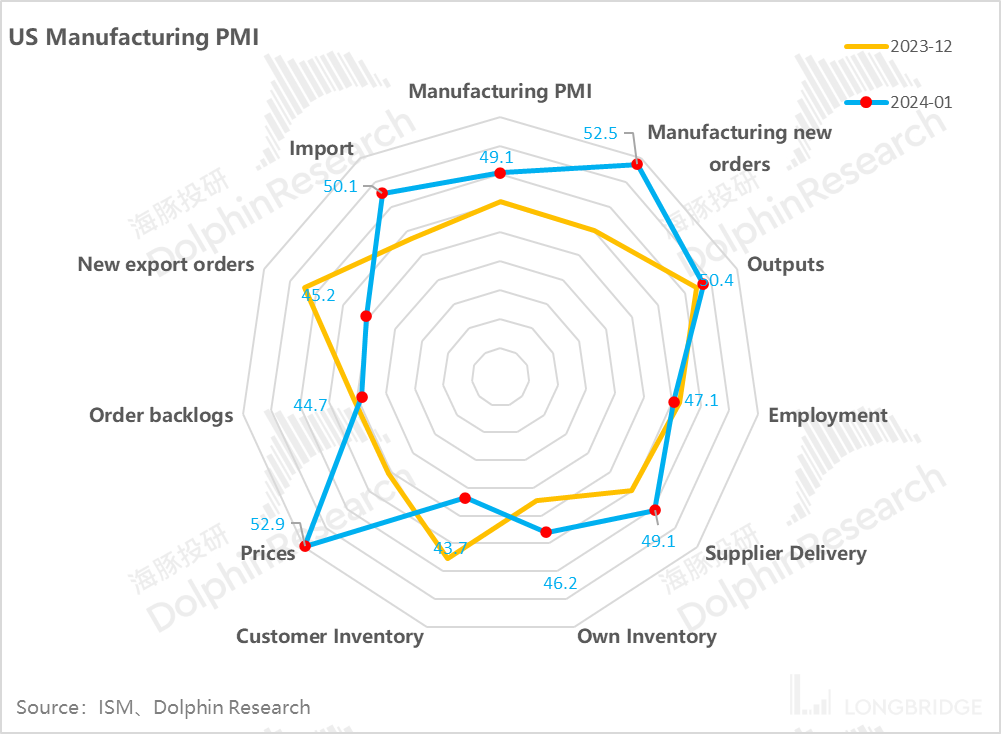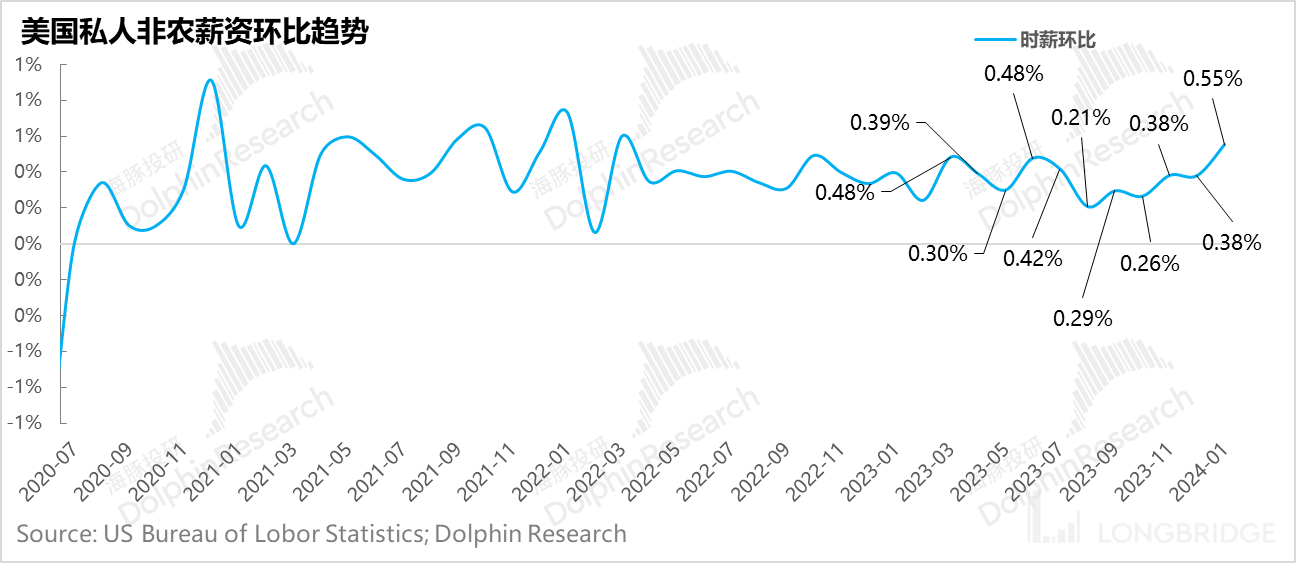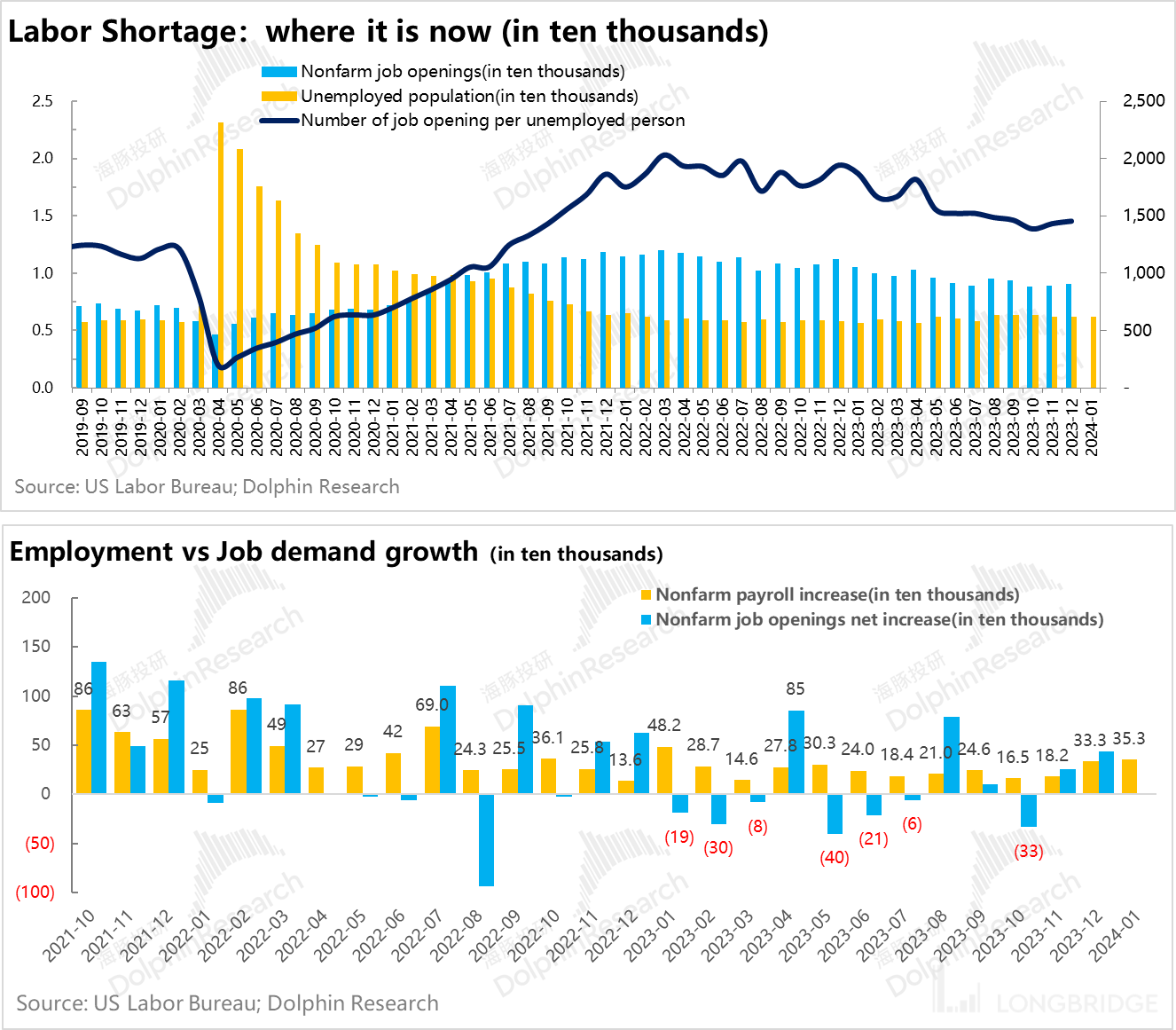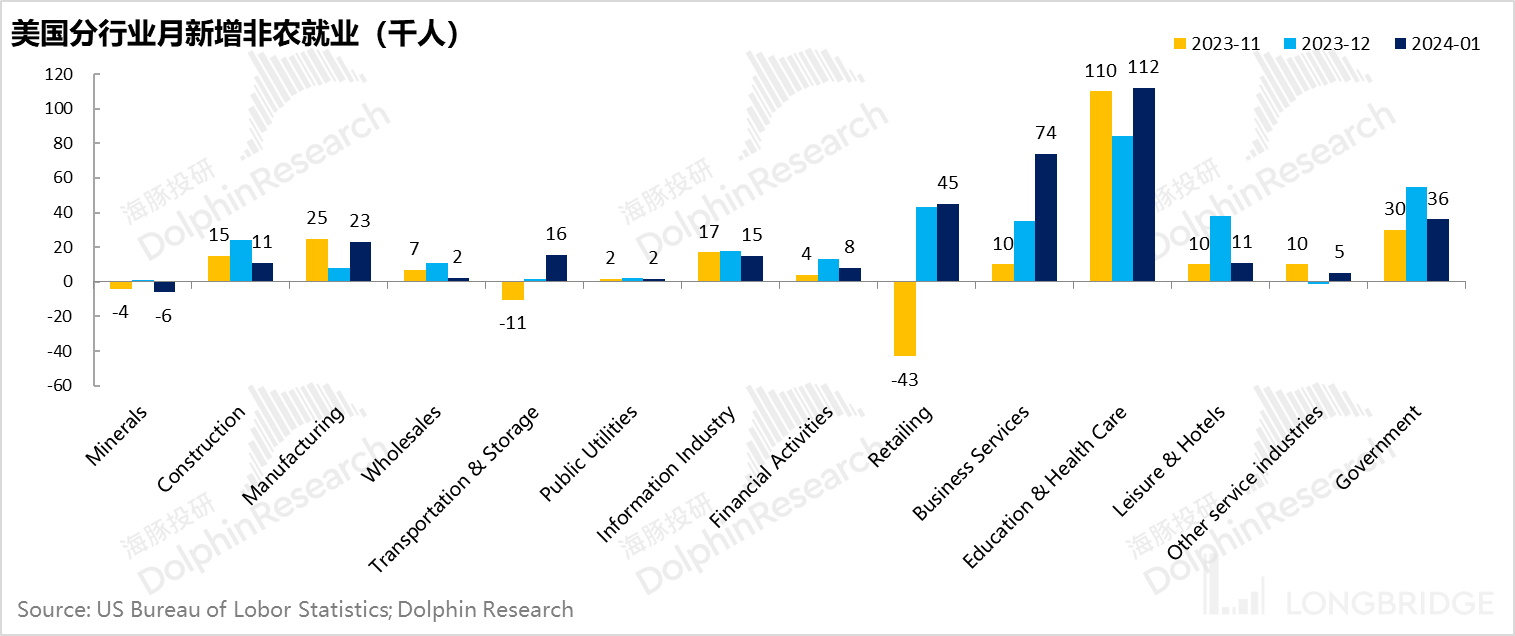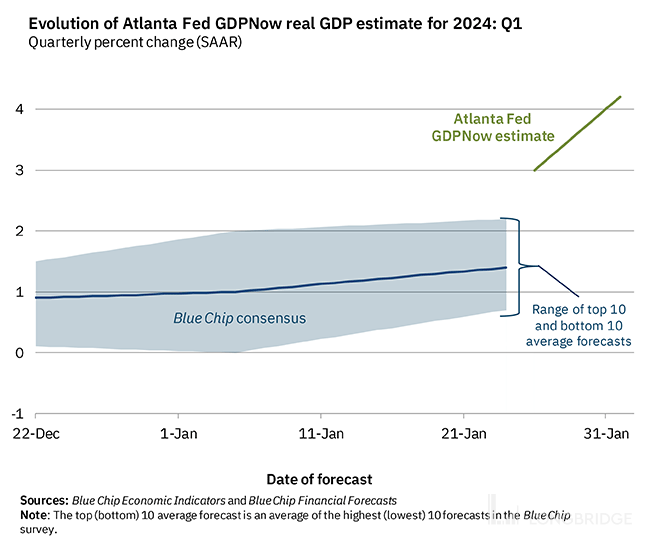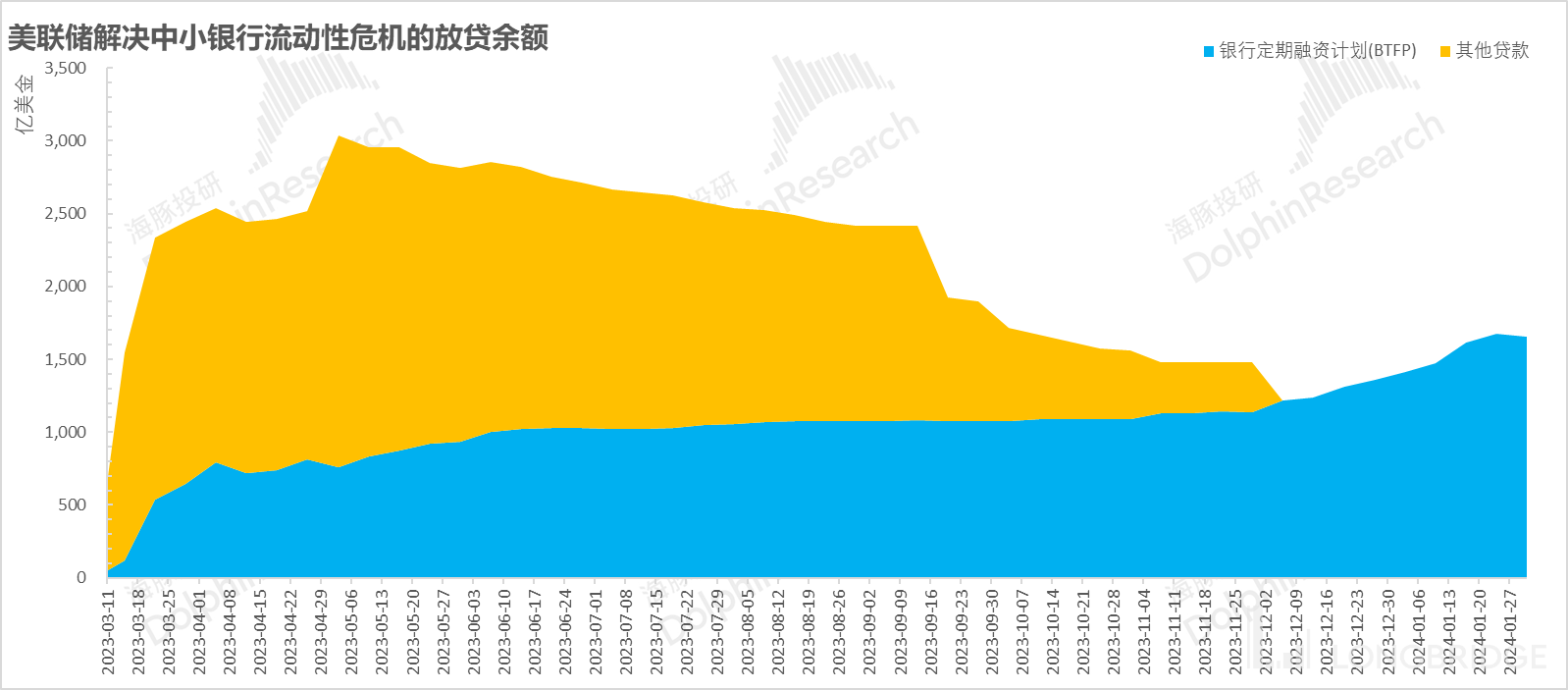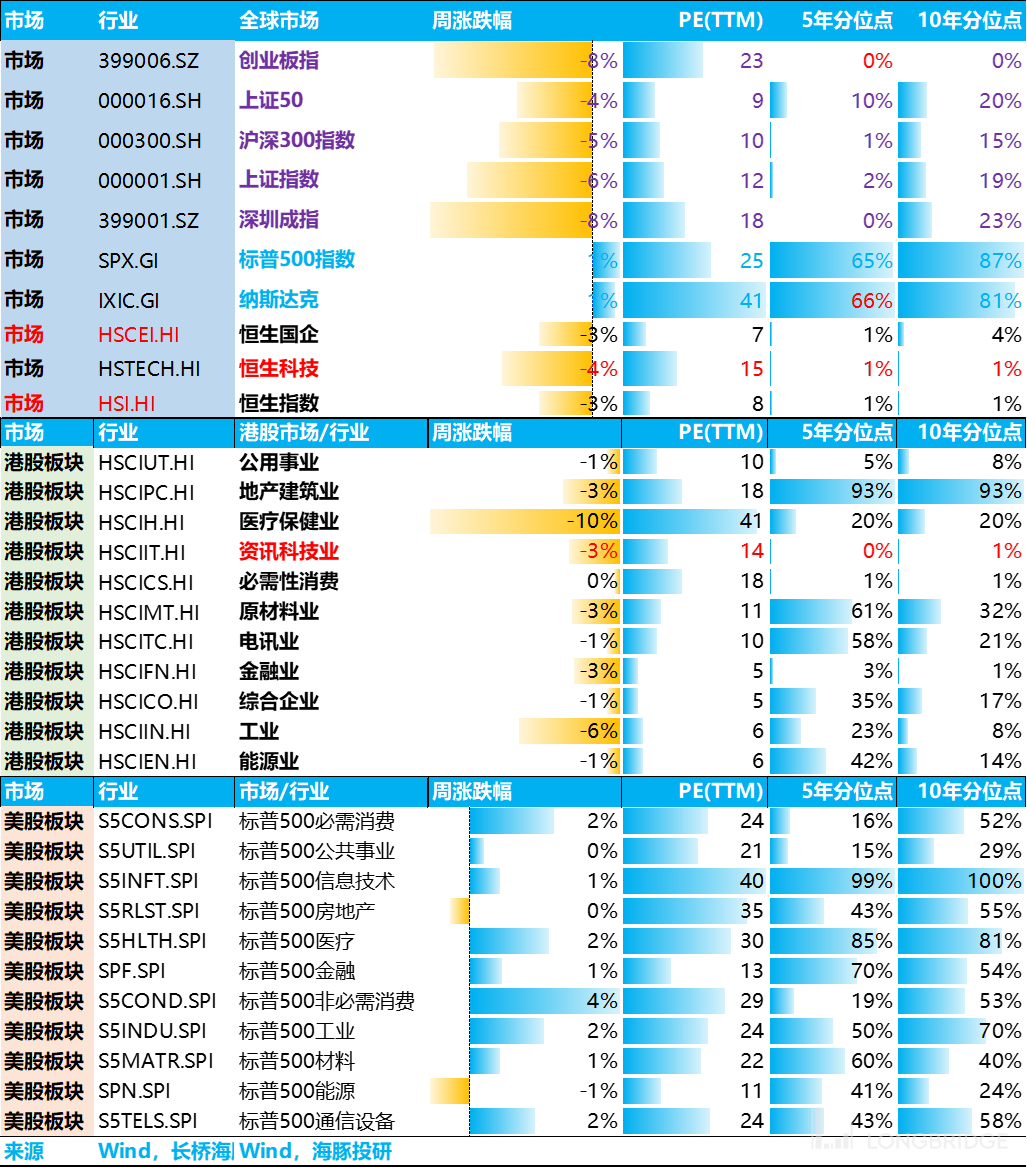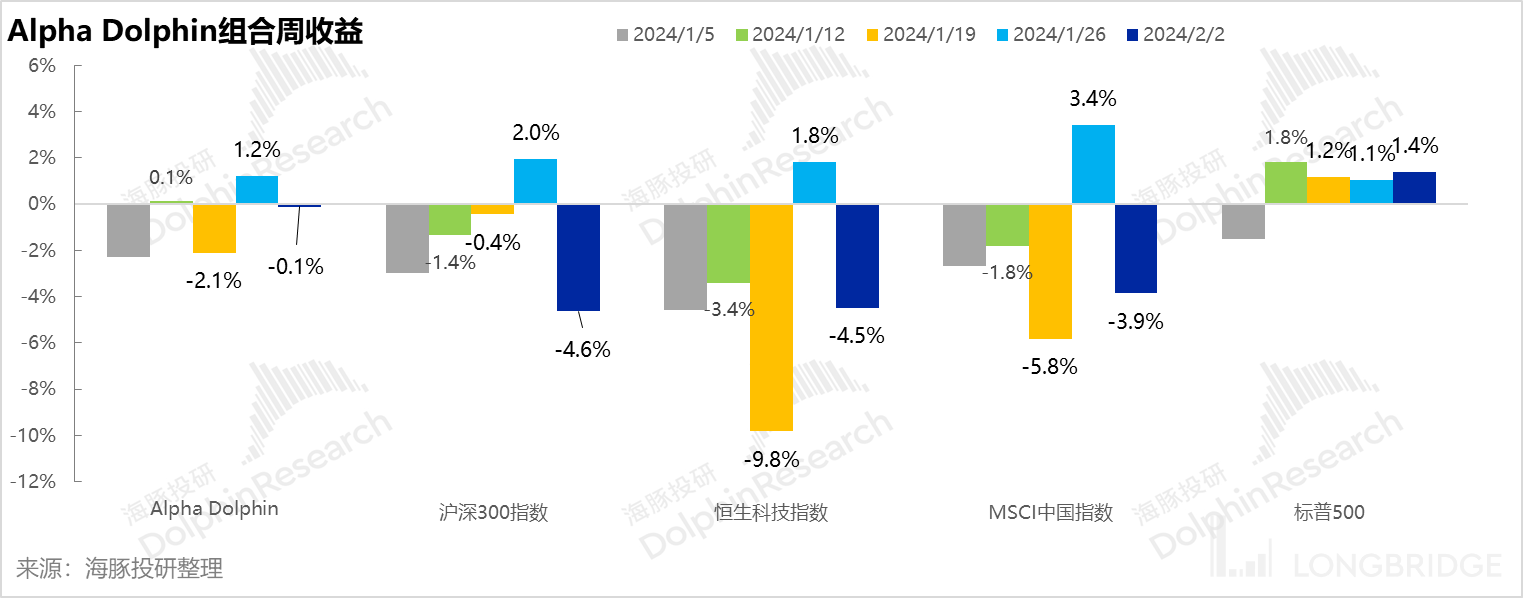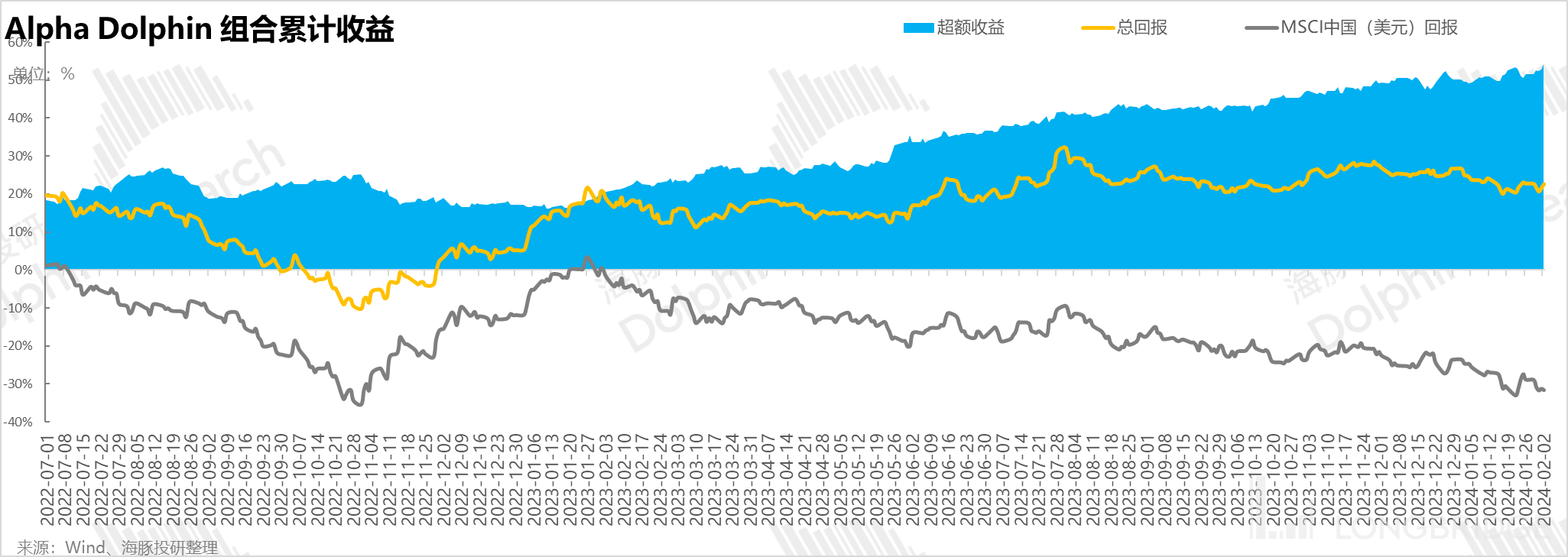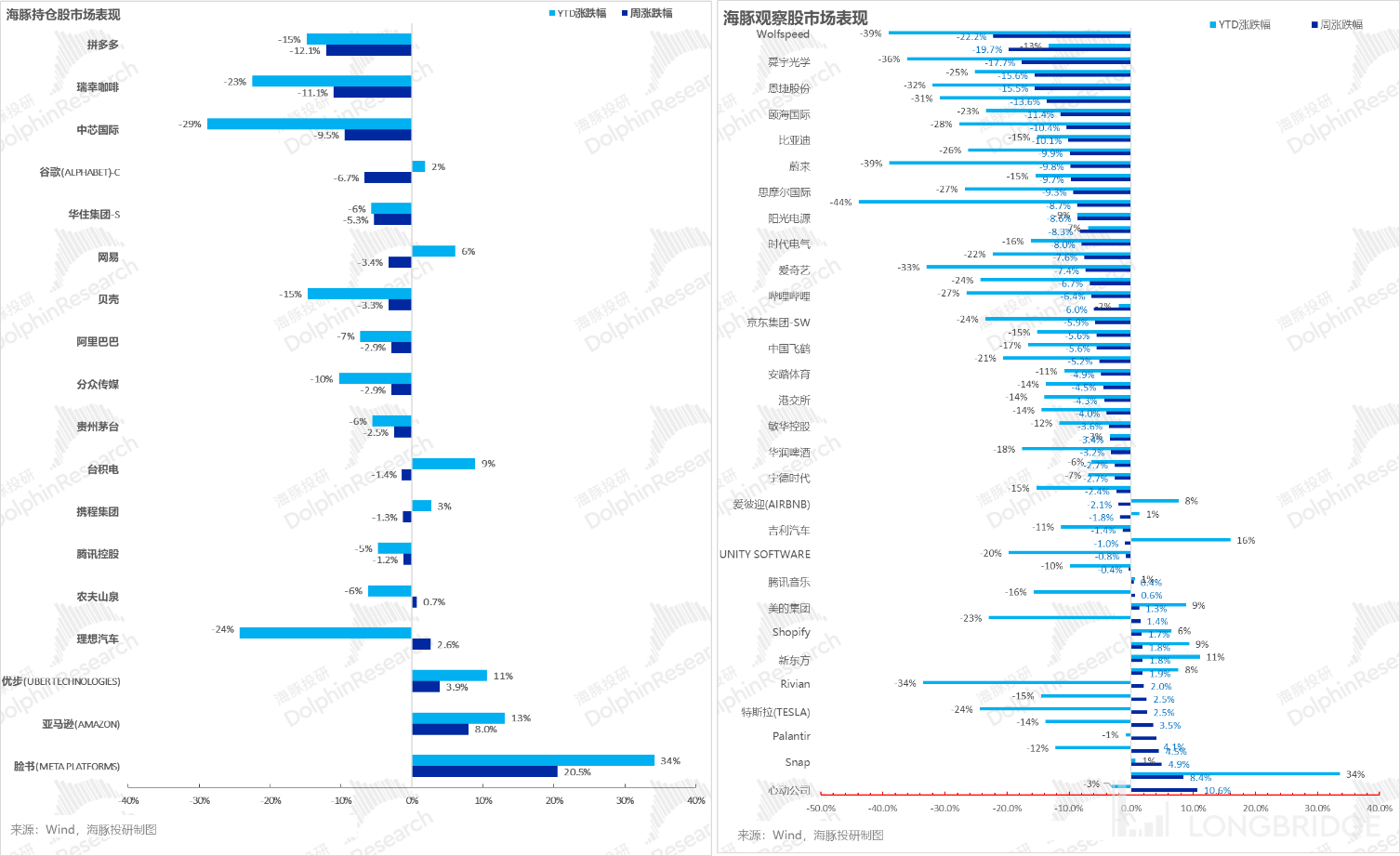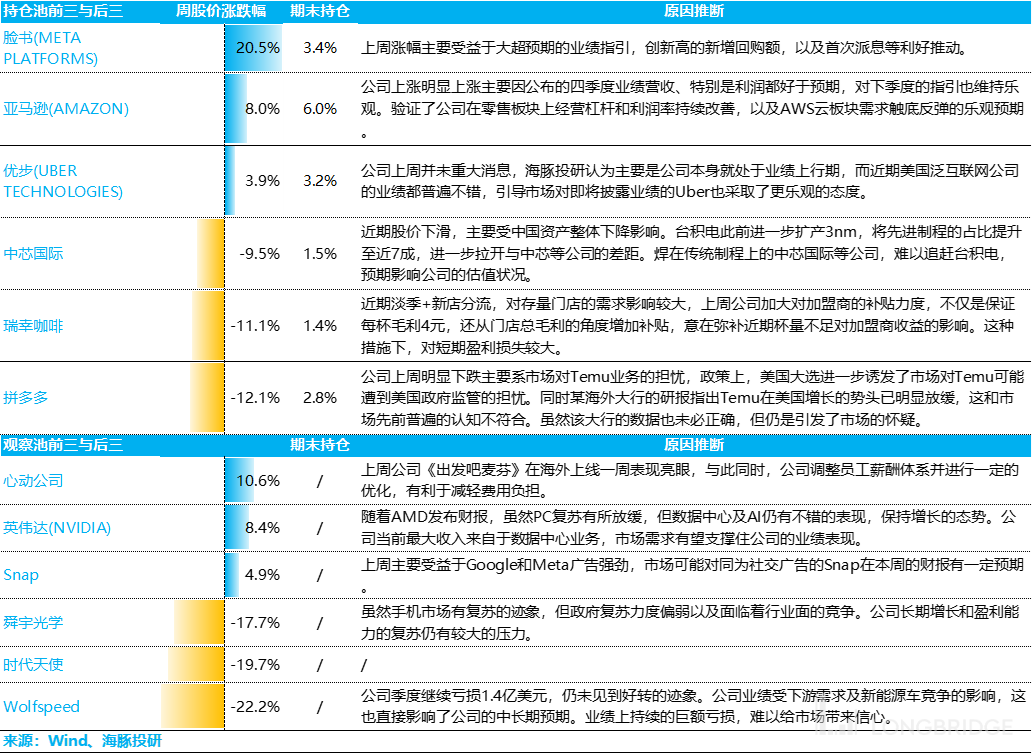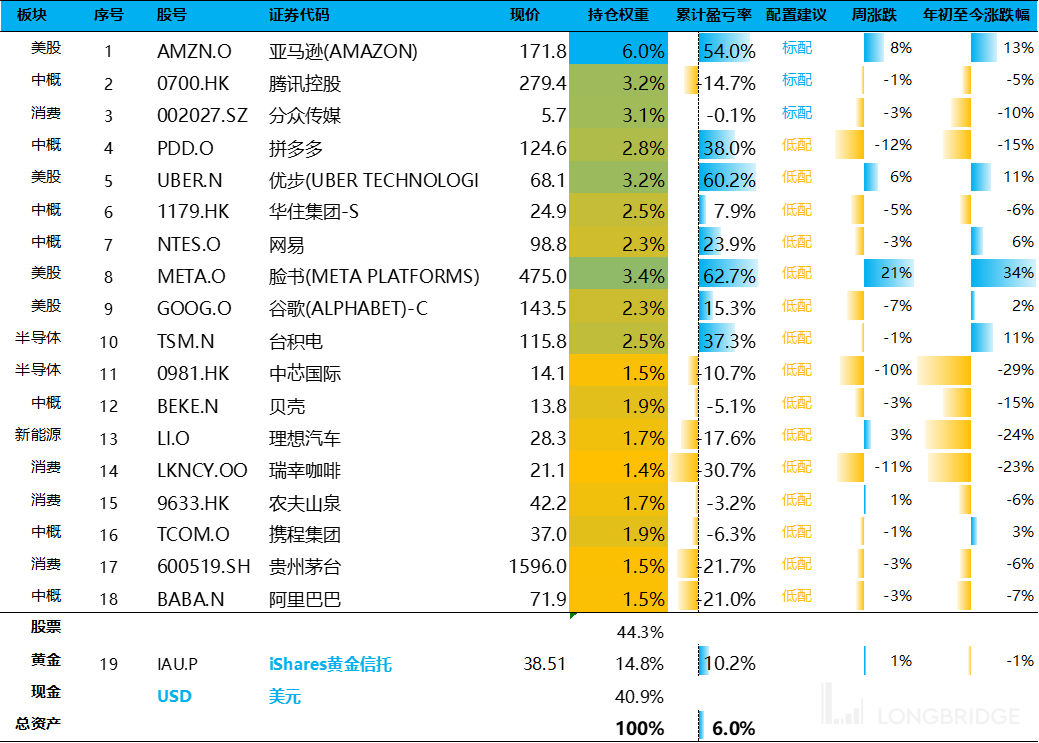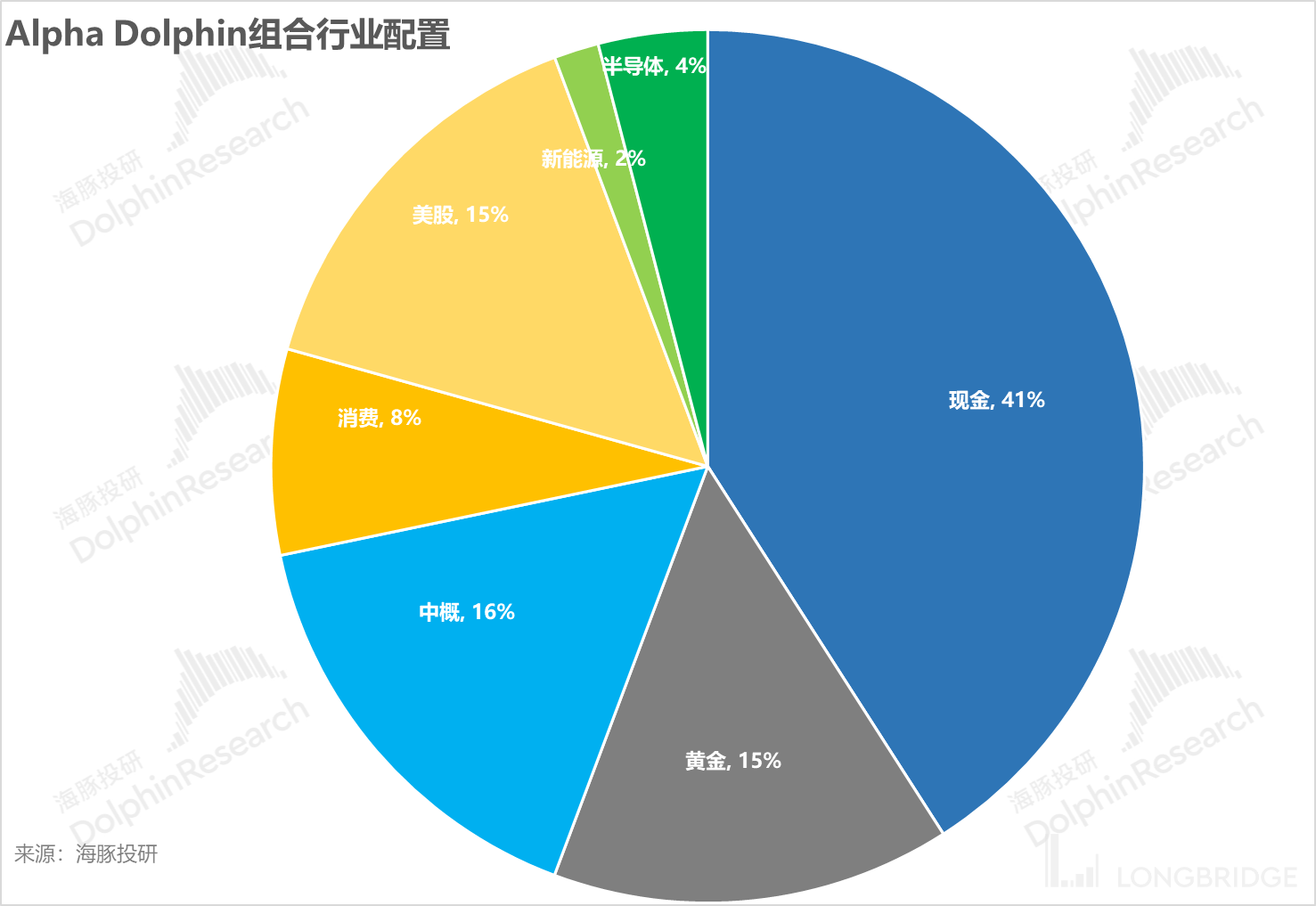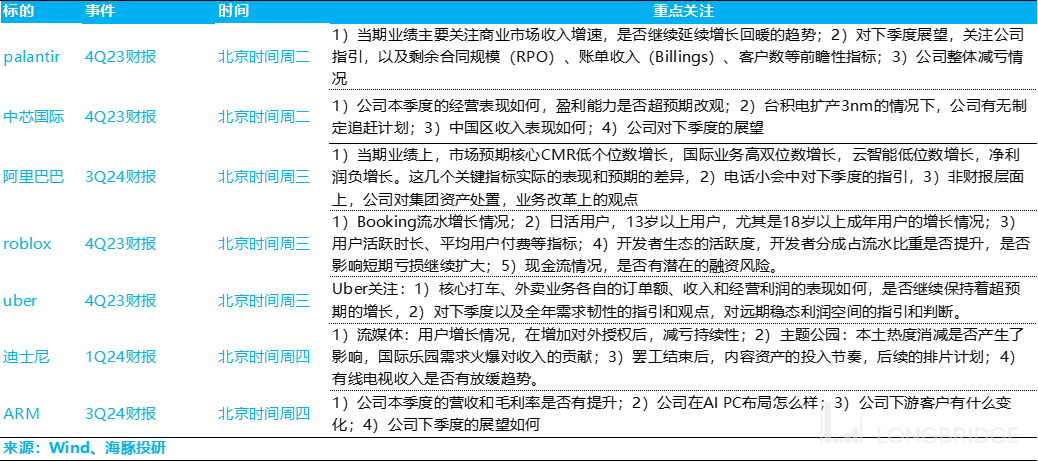
 Likes Received
Likes Received Posts
Posts2024, US economy no landing?

Hello everyone, here is Dolphin Research's summary of the core information on this week's portfolio strategy:
1) The manufacturing PMI sub price index has rebounded, wage growth has increased, labor market tightness has deepened, the large retail industry has clearly rebounded, and the new GDP economic forecast has already raised the US first-quarter GDP growth rate to over 4%... Even if the US economy is expected to slow down in 2024, the current situation in the first quarter is more like accelerated growth, topping the 3.3% growth in the fourth quarter, rather than a slowdown.
2) Based on this, it is still possible that the earnings of US stock giants will exceed expectations when the first-quarter results are released, as the current guidance from various companies still implies a stabilizing or slightly decelerating macroeconomic benchmark for the first quarter.
3) From the current plans and arrangements of the Federal Reserve and the Treasury Department for the second quarter, the Treasury Department will significantly reduce deficit financing, the Federal Reserve will slow down the pace of selling government bonds, and Powell's statement of a mid-year interest rate cut will resonate.
This will reduce liquidity risks in the second quarter. However, attention should still be paid to the absorption of bank reserve balances by fiscal financing in the second quarter after the excess reverse repo is exhausted, as well as the possible impact on the stock market.
4) Although it is close to the Spring Festival holiday this week, there are still many small and beautiful niche giants overseas releasing their earnings. In addition, among Chinese concept stocks, BABA-SWR will release its earnings before the New Year, which also needs to be closely watched. Dolphin Research will release interpretations and summaries as soon as possible, so please stay tuned.
Here are the details:
Starting from last week, the United States officially entered the period of releasing macroeconomic data for January. Judging from the strong PMI, employment, and wage data in January, the strong first-quarter performance guidance from US stock giants such as Amazon and Meta may be just a slightly conservative estimate.
I. Inflation Rising, No Landing?
First of all, the leading indicator, manufacturing PMI, has been hovering below 50 for a whole year. However, in January 2024, after new orders, prices, and import orders in the manufacturing sector expanded significantly, there are signs of returning to the 50 mark. It is worth noting that the manufacturing price index has returned to the expansion range for the first time in 9 months.
In addition, with the expansion of prices, the customer inventories of manufacturing companies have rapidly shrunk. This reflects that in the case of strong end demand, the inventories of manufacturing customers are being rapidly consumed, indicating an upward turn in the cycle.

What is even more important is the hourly wage data for January: the MoM increase has risen significantly to 0.55% (YoY increase as high as 6.8%), not only accelerating but also with a considerable magnitude.
The nominal wage growth corresponding to the Fed's inflation target should be in the range of 0.2-0.35%. The last time nominal wages reached this level was in December 2021 when inflation was rampant (the YoY core CPI was 6.5% at that time).

II. Continuous Boom in Employment
Let's talk about the supply and demand in the labor market in December. Since the return of striking workers in November, the US job market has once again seen a net increase in positions, with the number of net job additions by companies exceeding the number of new jobs for two consecutive months. This has led to a tightening labor market in the US. In October, there were 1.39 job openings for every unemployed person, and by December, this ratio had increased to 1.46.

Based on the data released so far in January, it seems that the situation of tight supply will continue to worsen. The number of new jobs in January has increased to 353,000, but at the same time, the number of people entering the labor force has decreased seasonally.

Companies only increase capital expenditure and hire more people when they have optimistic prospects and profits. Conversely, the trend of job growth in each industry is also a reflection of the industry's performance. Let's use the data from December and January to roughly judge which industries will perform relatively well:
a) Trending Upward - Retail Industry: For most of the past year, employment in the US retail industry has been stagnant, but it has started to hire significantly again since December.
Looking at the breakdown, there has been a significant increase in new hires in retail stores, including department stores, warehouses, supercenters, and stores selling books/music/sports goods. At the same time, there has also been a considerable number of new hires in the transportation industry, particularly in warehousing and express delivery related to e-commerce logistics. The combination of these two data reflects the prosperity of the entire retail industry.
b) Trending Upward - Information Industry: In the information technology sector, there has been an accelerated hiring in the film and television production related to the entertainment industry. The expansion of computer-related jobs in this sector, as well as the hiring of computer system designers in professional services, implies that the situation in the technology industry, including information, media, and communication, is also favorable.
c) Continuously Thriving - Healthcare Industry: Emerging from the pandemic, this industry seems to be an insatiable giant. From family doctors to hospital physicians, from home care to hospital nursing, there is a continuous need for new hires every month, but there are still many vacant positions waiting to be filled.
e) Continuously Thriving - Construction Industry: There has been a small increase in new hires in both residential and non-residential construction, indicating a rebound in the industry. The majority of new hires come from third-party trade outsourcing in non-residential construction. This reflects the impact of Biden's three major bills, as judged by Dolphin Research. f) Dullness - Financial and Accommodation Industries: The financial industry is experiencing continuous layoffs after industry mergers and acquisitions, while the accommodation industry seems to be experiencing a seasonal slowdown after the Chinese New Year.

Overall, based on the data released in January, the United States does not seem to be weakening marginally, but rather the weak cycle has already ended and there is a feeling of upward momentum. If this trend continues, the GDP growth rate in the first quarter is likely to accelerate.
The forecast data from the Atlanta Federal Reserve in the United States seems to coincide with Dolphin Research's speculation. Based on the latest construction, ISM, employment, and other data, the regional Federal Reserve's GDPNow model updated its GDP forecast on February 1st, showing that the GDP growth rate in the first quarter of the United States has reached 4.2%, higher than the 3.3% growth rate in the fourth quarter of last year.

III. Dovish Fiscal Financing vs Hawkish Federal Reserve: Coincidence or Intentional
From a liquidity perspective, Dolphin Research has noticed some interesting resonances: while the U.S. Treasury has lowered its financing target for the first quarter in its latest financing plan, the financing scale for the second quarter is only one-third of the previous four quarters.

At the same time, the Federal Reserve's quarterly $180 billion bond sales and the Treasury Department's quarterly $400-500 billion fiscal deficit indicate that the Treasury Department's net financing scale should be between $600-800 billion. Moreover, according to the Federal Reserve's statement, the BTFP tool ($165 billion) will not be renewed when it expires at the end of March.
The actual amount of market funds absorbed should be between $800 billion and $1 trillion. If the current $980 billion reverse repurchase reaches a surplus of two to three hundred billion, it will reach its limit, and most of the shortfall will be made up by the end of the first quarter.

Combining Powell's interview on the latest 60 Minutes news: there is a high probability that there will be no interest rate cut in March, and the interest rate cut for this year will occur in the middle of the year. Therefore, Dolphin Research estimates that the interest rate cut is likely to begin in June.


And when all this information is put together, Dolphin Research believes that a possible scenario for the liquidity situation in the second and third quarters is as follows:
The Federal Reserve will not cut interest rates in the second quarter, but will slow down the pace of selling government bonds, such as reducing it from 60 billion to 30 billion, to reduce the liquidity pressure after the excess reverse repurchase balance is depleted.
The Treasury Department will reduce financing to $200 billion and temporarily use tax payment flows to fill the current deficit hole.
However, overall, in the second quarter, due to the depletion of excess reverse repurchase balance, even if the Treasury reduces financing and the Federal Reserve reduces the scale of bond sales, it is feared that bank reserve balances will still need to decline to make up for the loss. However, it cannot be ruled out that the stock market may be slightly affected.
Starting in the third quarter, the Treasury Department will once again enter a period of large-scale borrowing, but by then the interest rate cut will have been initiated, which will drive down long-term interest rates. The financing cost pressure for the Treasury Department to issue long-term bonds will also be reduced.
In addition, it should be noted that if the first interest rate cut occurs in June, it will coincide with the start of the US presidential election: in mid-July, the Republican Party will select its presidential candidate, and in September, the two parties' candidates will have a major debate. The current Republican candidates have expressed on multiple occasions that they do not want Powell to be reappointed.
Although the Federal Reserve has always emphasized its neutrality, when these timing factors are put together, it still subtly implies monetary and fiscal cooperation to support the Democratic Party's election.
IV. Where is the market heading?
From the current valuation status of the main markets, US stocks are still overvalued. However, the question is, if the future macroeconomic conditions improve rather than weaken, and if earnings can digest the high valuations, and if liquidity remains relatively abundant in the first quarter, then there seems to be room for selecting preferred stocks in the US market until the end of the first quarter.
At the same time, some Hong Kong stocks have already reached an extreme oversold state, and Dolphin Research will continue to pay attention to opportunities for oversold rebounds in individual stocks under excessively pessimistic conditions.

V. Portfolio Returns
On February 2nd, Alpha Dolphin's virtual portfolio returns slightly declined by 0.1%, lagging behind the S&P 500 (+1.4%), but outperforming the CSI 300 (-4.6%), Hang Seng Tech Index (-4.5%), and MSCI China (-3.9%).

This is mainly because although Dolphin Research accurately predicted the strong performance of US stocks in this earnings season, such as Meta and Amazon, last week's main issue was the significant decline in stocks such as Pinduoduo and Luckin Coffee, which dragged down the portfolio performance.
From an individual stock perspective, Chinese concept assets have also been a core reason for the continuous drag on portfolio returns during this period. However, Dolphin Research's conservative Chinese concept assets are mainly focused on core assets with no short-term or medium-term flaws in their fundamentals, so Dolphin Research has not made any adjustments. From the start of the self-combination test to last weekend, the portfolio's absolute return was 23%, with an excess return of 54% compared to MSCI China. From the perspective of net asset value, Dolphin Research initially had virtual assets of $100 million and currently has $125 million.

VI. Individual Stock Profit and Loss Contribution
The rise and fall of Dolphin Research's holdings and watchlist last week were mainly driven by two factors: the performance-driven fluctuations in US stocks during the earnings season, and the downward trend of Chinese concept stocks under various negative news.

Regarding the major gainers and losers in Dolphin Research's holdings and watchlist last week, as well as the possible reasons, Dolphin Research's analysis is as follows:

VII. Portfolio Asset Allocation
Alpha Dolphin's virtual portfolio did not make any adjustments this week, with a total of 18 stocks in its holdings, including three core holdings and the rest being underweighted equity assets, with the remaining assets in gold and US dollars.
As of last weekend, the asset allocation and equity asset weightings of Alpha Dolphin were as follows:


VIII. Key Events this Week
This week, the US stock market officially entered the earnings season for small and medium-sized companies. The focus will be on the earnings release of Chinese concept stocks, with particular attention to BABA-SWR. Dolphin Research has summarized the specific points of focus as follows:

Risk Disclosure and Statement for this Article: Dolphin Research Disclaimer and General Disclosure
For recent articles in Dolphin Research's portfolio weekly report, please refer to:
["Another Critical Moment! Will Powell Bail Out the Prodigal Yellen?"](https://longportapp.cn/topics/11390496? 《Another test of faith, how many beliefs can withstand the test?》
《Unstoppable deficit, supporting the dignity of the US stock market》
《2024 United States: Good economy, fast interest rate cuts? Too good to be true, will suffer losses》
《Rebirth through suicide in the United States in 2023》
《The Fed makes a sharp turn, can Powell resist Yellen?》
《Year-end US stocks: Small gains bring joy, big gains harm health》 Consumer Stalling, Is the US Only One Step Away from Interest Rate Cuts Despite the Fed's Tough Talk?
US Stocks Overdrawn Again, Is it Finally Time for Chinese Concept Stocks?
The "Sun Never Sets" Faith in US Stocks is Back, Is it Reliable This Time?
High Interest Rates Can't Dampen Consumption, Is the US Really Thriving or Just Hype?
The Second Half of Fed Tightening, No Escape for Stocks and Bonds!
The Most Down-to-Earth, Dolphin Investment Portfolio is Launched
The copyright of this article belongs to the original author/organization.
The views expressed herein are solely those of the author and do not reflect the stance of the platform. The content is intended for investment reference purposes only and shall not be considered as investment advice. Please contact us if you have any questions or suggestions regarding the content services provided by the platform.

